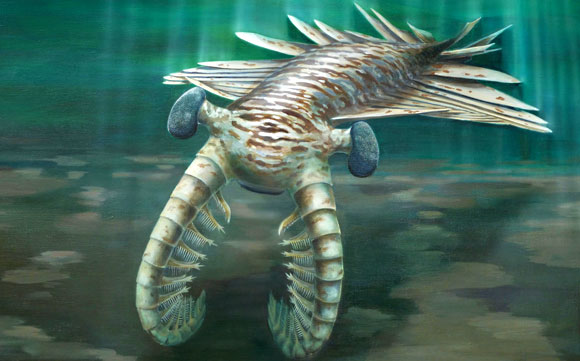Dinocaridida
 The Cambrian apex preditor Anomalocaris canadensis (Dinocaridida - Anomalocarididae). This animal had unparalled vision by Cambrian, or even contemporary, standards. Note the stiff (not cuttlefish-like) swimming lobes. The Cambrian apex preditor Anomalocaris canadensis (Dinocaridida - Anomalocarididae). This animal had unparalled vision by Cambrian, or even contemporary, standards. Note the stiff (not cuttlefish-like) swimming lobes.
Artwork by Katrina Kenny, commissioned by the University of Adelaide. (see also Everything Dinosaur
Picture Credit: Katrina Kenny/South Australian Museum/University of Adelaide. |
Anomalocaris
Cambrian superpredator
early Cambrian to Early Ordovician
nektonic apex predator
length: half a meter or more
Anomalocaris canadensis was about 60 cm long, which may not seem much in today's terms, but was huge relative to anything else around during the Cambrian and Early Ordovician (some specimens seem to have been even larger, a meter in the case of one early Ordivician giant). For tens of millions of years this slow-moving swimmer dominated Cambrian seas. It had a pineapple-ring mouth and a pair of long spiky grasping appendages. It was originally believed to be three separate animals (the pineapple ring mouth was thought to be a jellyfish (Peytoia) - the large lobed body a sponge, the grasping appendages the body of a crustacean - that was the original "Anomalocaris"). Swimming was accomplished by means of undulations of fin-like appendages along the side of the body (and as shown in the above illustration, these would have been stiff, like blades of fan, not soft like those of a cuttlefish or sea slug.
Anomalocaris early on acquired something of a mystique rare among prehistoric invertebrates. Because of its relative size and carnivorous habits (for a number of reasons we do not consider the hypothesis that it was a suction feeder of plankton or worms persuasive), it has become a kind of T. rex of the Cambrian, a reputation that was probably well deserved.
Other Cambrian creatures like Opabina (itself a close cousin, unexpectedly) and Sanctocaris (a stem Chelicerate) were also probably predators, but at 7 to 10 cm are much smaller.
We now know of more than a dozen different species of Anomalocaridids, which would only be a fraction of their original diversity. They have been given their own class , Dinocaridida, the "terrible shrimps" , although calling these creatures shrimps is about as appropriate as calling dinosaurs lizards (sauros); such are the limitations of Greek and Latin suffixes. MAK990601, revised and updated MAK120507,
notes:
Ref for the original paper on Anomalocaris: Whittington H.B. & Briggs D.E.G., "The Largest Cambrian Animal, Anomalocaris, Burgess Shale, British Columbia", Philosophical Transactions of the Royal Society, 1985, B 309, pp.569-609
New Nature article: John R. Paterson, Diego C. García-Bellido, Michael S. Y. Lee, Glenn A. Brock, James B. Jago & Gregory D. Edgecombe (2011). "Acute vision in the giant Cambrian predator Anomalocaris and the origin of compound eyes". Nature 480 (7376): 237–240. doi:10.1038/nature10689.
 The Cambrian apex preditor Anomalocaris canadensis (Dinocaridida - Anomalocarididae). This animal had unparalled vision by Cambrian, or even contemporary, standards. Note the stiff (not cuttlefish-like) swimming lobes.
The Cambrian apex preditor Anomalocaris canadensis (Dinocaridida - Anomalocarididae). This animal had unparalled vision by Cambrian, or even contemporary, standards. Note the stiff (not cuttlefish-like) swimming lobes.